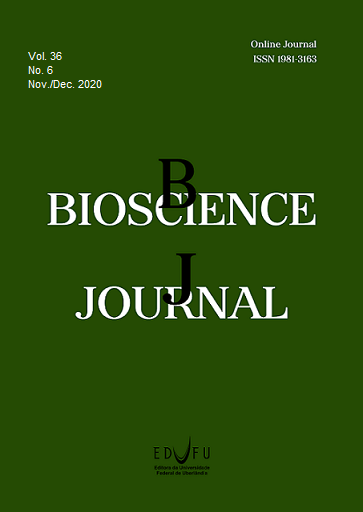IgE AND IgG antibody responses to Dermatophagoides pteronyssinus in dogs with demodicosis and atopic dermatitis
DOI:
https://doi.org/10.14393/BJ-v36n6a2020-48029Keywords:
Demodex canis., Demodicosis., Dermatophagoides pteronyssinus., . IgG. IgE, DogsAbstract
Canine demodicosis is a common inflammatory parasitic skin disease caused by Demodex mites. House dust mites, such as Dermatophagoides spp., play an important role in the pathogenesis of canine atopic dermatitis (AD). The goal of this experimental work was to investigate whether demodectic dogs could be previously exposed/sensitized to house dust mites’ antigens. First the prevalence of demodicosis in a southeastern region of Brazil was investigated by analyzing clinical files of dogs that were admitted to a Veterinary Hospital. Subsequently, the IgG responses to Dermatophagoides pteronyssinus (Dp) and Dermatophagoides farinae (Df) and IgE to D. pteronyssinus (Dp) were evaluated in two groups, AD or demodicosis dogs. Additionally, the major IgE-binding Dp proteins that are recognized by sera from dogs with demodicosis and AD were evaluated. A total of 2,599 clinical files were analyzed to identify the major parasitic skin diseases in dogs from this region, considering the age, sex and breed of the animals. The epidemiological study identified 111 animals with skin diseases; from these 20.7% presented demodicosis. Afterwards, serum samples were obtained from another groups of demodicosis, AD, and healthy dogs, and analyzed for Dp and Df-specific IgG, and IgE antibody levels, Dp IgG avidity by ELISA and IgE-binding Dp-specific proteins by immunoblot. IgG and IgE antibodies to Dp were detected in sera from additional groups of dogs with AD, demodicosis or healthy, with higher IgE levels to Dp in AD than demodectic or healthy dogs. IgG to Df was detected, despite with smaller levels compared to Dp in sera from demodectic dogs, and also in healthy dogs. Immunoblot showed IgE-binding to Dp proteins in sera of dogs with demodicosis and AD; with strong reactivity for the 72 and 116 kDa antigens detected by sera from demodicosis dogs. However, sera from healthy dogs >12 months old also presented reactivity to these bands. In conclusion, the detection of Dp-IgG and IgE antibodies in sera from demodectic dogs indicates previous exposure and sensitization to the house dust mite, respectively, more than cross-reactivity between demodex mites and Dp antigens detected by canine antibodies. Additionally, higher Dp-specific IgE levels were found in dogs with AD compared with those with demodicosis or healthy, suggesting that Dp-specific IgE could better discriminate dogs with AD from healthy ones or even those with demodicosis.
Downloads
Downloads
Published
How to Cite
Issue
Section
License
Copyright (c) 2020 Maria Cecília Oliveira, Ana Cláudia Arantes Marquez Pajuaba, José Eugênio Diniz Bastos, José Roberto Mineo, Fabiana Parreira Souza, Ester Cristina Borges Araújo, Marcos Paulo Oliveira Almeida, Deise Aparecida Oliveira Silva, Ernesto Akio Taketomi, Neide Maria Silva

This work is licensed under a Creative Commons Attribution 4.0 International License.





